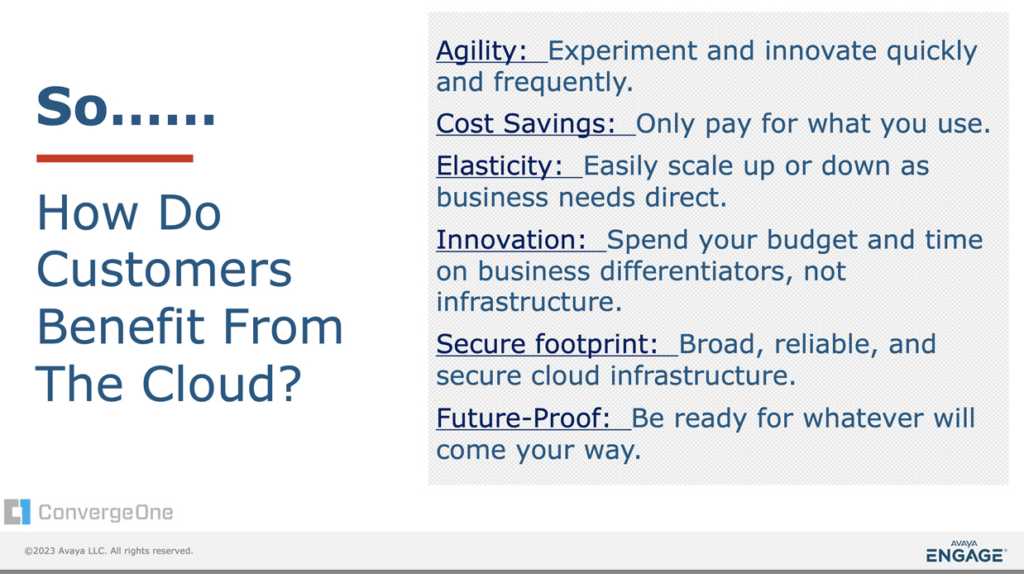By David Lover, Vice President Strategy and Technology, ConvergeOne

Now is a great time for IAUG members to be planning your move to the cloud – as long as you are doing so for the right reasons. It’s not always the easy “I need to cut my costs” justification that first comes to mind. There can definitely be cost savings, but this generally requires rethinking your business processes and workflows to adapt to the modernized applications that were completely rewritten to exist natively in the public cloud.
“Just take what I already have and move it to the cloud as-is” is usually a recipe for disaster and generally misses the point of cloud modernization. I find most Avaya users are romanticizing their glory days of moving their physical servers to virtual machines. There you had huge cost savings and very little disruption to the business, because all you did was trick your existing applications into thinking they had their own dedicated hardware. But the applications themselves, and the business units that used them, had zero change. So, big technology modernization, and zero business modernization.
Finding the right reasons
At Avaya ENGAGE in Orlando, I delivered a presentation on “How Will I Know When it’s Time to Move to the Cloud?” In that session, I focused on six main topics to help find those right reasons: business goals, cost, scalability, features, reliability, and security. Do they cover everything? I wish. But it’s a starting point. It can get you thinking about the real benefits and value of cloud. Here’s a high level overview of those key topics.
Aligning with Business Goals
To gauge the right time for cloud adoption, it’s crucial to align it with your long-term business goals. Consider aspects like agility, flexibility, and the ability to support remote work and seamless collaboration. If your objectives revolve around scaling operations, enabling remote workforces, or integrating communication channels seamlessly, the cloud can serve as a catalyst to propel your business forward.
Cost Considerations
When contemplating a transition to cloud, a comprehensive cost analysis is essential. Weigh the expenses associated with maintaining legacy infrastructure, including hardware, maintenance, and upgrades, against the predictable subscription-based pricing models offered by cloud providers. Explore potential cost savings, particularly if your business plans to scale up or downsize in the future.
Scalability
Evaluate your organization’s growth trajectory and the current telephony solution’s scalability. Cloud offers unmatched flexibility to easily scale up or down based on your evolving business needs. This eliminates the need for significant infrastructure investments or complex configuration changes, empowering your business to adapt swiftly in a dynamic market.
Advanced Features and Functionality
Take stock of the advanced features and functionalities presented by cloud solutions. Evaluate offerings such as virtual attendants, intelligent call routing, video conferencing capabilities, unified communications, and seamless integration with other business applications. Consider how these capabilities align with your organization’s communication requirements and future growth plans.
Reliability and Redundancy
Assess the reliability and redundancy of your existing telephony infrastructure. Cloud solutions often provide robust redundancy measures, ensuring uninterrupted communication during outages or unforeseen circumstances. Analyze the impact of potential downtime on your business operations and embrace the reliability benefits offered by reputable cloud providers.
Security and Compliance
Security is a paramount concern in today’s digital landscape. Evaluate the security measures and compliance certifications provided by cloud telephony providers. Scrutinize factors such as data encryption, stringent access controls, comprehensive threat monitoring, and adherence to industry regulations like GDPR or HIPAA. Ascertain whether a cloud-based solution can offer superior security compared to your current infrastructure.
Conclusion
Deciding to transition your telephony and contact center to the cloud is a strategic move that can revolutionize your organization’s communication ecosystem. By meticulously evaluating criteria such as business goals, cost, scalability, features, reliability, and security, you can confidently determine the optimal time to embrace cloud telephony and contact center.
Remember, each business is unique, so consider your specific needs and priorities while seeking guidance from experienced technology partners or consultants. Embracing cloud unlocks new levels of efficiency, collaboration, and agility, propelling your business towards a successful digital future.
A diamond sponsor at Avaya ENGAGE, ConvergeOne helps organizations design, install, and manage their Avaya on-prem, hybrid and cloud environments.
